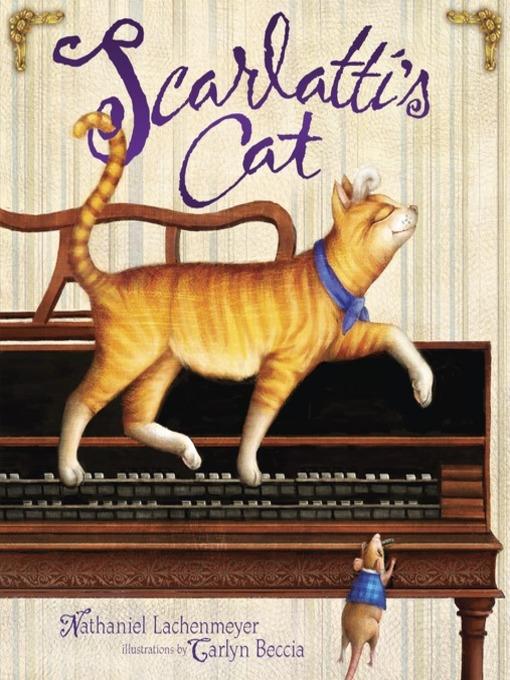
Scarlatti's Cat
فرمت کتاب
ebook
تاریخ انتشار
2014
Lexile Score
740
Reading Level
2-4
ATOS
3.7
Interest Level
K-3(LG)
نویسنده
Carlyn Becciaشابک
9781467724012
کتاب های مرتبط
- اطلاعات
- نقد و بررسی
- دیدگاه کاربران
نقد و بررسی

January 13, 2014
Lachenmeyer’s (The Boo! Book) faux biography of a famous composer hits an odd off-note. When Pulcinella, the butterscotch cat that belongs to 18th-century Italian composer Domenico Scarlatti, lands on the master’s harpsichord in pursuit of a mouse, Scarlatti discovers that the cat is as good a composer as he is. “Scarlatti started to push her off, but then he heard the melody she was playing. He was amazed.” He sets down the cat’s composition (there is, in fact, a Scarlatti piece nicknamed the “Cat fugue”) then tests Pulcinella again the next morning—and she plays even more beautifully. Is Scarlatti pleased? He is not. “What will become of me?” he cries. Then he packs the cat into a basket and gives her away. Even if it were true (biographies date the “Cat fugue” nickname to the 19th century), there’s little to laugh at in the image of silencing artistry that threatens one’s success—though it does, perhaps, say something about human nature. Beccia’s (Louisa May’s Battle) pale, waxworklike figures and baroque flourishes create a distinctive atmosphere and ensure that readers’ loyalties will remain with Pulcinella. Ages 4–9.

January 15, 2014
Despite an intriguing premise, Lachenmeyer and Beccia's collaboration doesn't quite manage to produce a pleasing composition. Legend has it that Scarlatti's "Sonata in G Minor" was inspired by his pet cat, Pulcinella. Lachenmeyer uses this as a jumping-off point and imagines that the fancy feline has a particular interest in (and talent for) composition. Though initially stymied by Scarlatti's dictum that no one may touch his harpsichord, Pulcinella gets her chance one day when a bold mouse in a bright blue vest pops up and leads both cat and master on a merry chase. When her paws hit the keys, Pulcinella begins to play. Initially captivated, Scarlatti later worries about the impact of her talent on his livelihood and decides that passing his pet on to a friend is the best way to protect himself and other composers. Beccia's illustrations feature subdued colors, elaborate details and faux crackling to enhance the historical feel. Unfortunately, the stiffness of the figures, though artistically appropriate, creates a sense of distance. Unlikely events, uneven pacing, and the unsettling, if ultimately amusing, finale further reduce the already limited appeal. Music lovers might appreciate this slight story that ties the creation of a popular classical sonata to a pampered pet, but most young listeners will simply be left wondering what poor Pulcinella did to be abandoned by her owner. (author's note) (Picture book. 5-8)
COPYRIGHT(2014) Kirkus Reviews, ALL RIGHTS RESERVED.

February 1, 2014
K-Gr 2-According to legend, Domenico Scarlatti's Sonata in G Minor (generally known as the "Cat's Fugue") was inspired by the composer's cat. This book tells the rest of the story. Pulcinella loves to listen to Scarlatti play his harpsichord, but what she really wants is to compose her own music. However, she never breaks his strict house rule-no one is allowed to touch his harpsichord. Then one day she spots a mouse in the music room and gives chase. The wild romp ends with Pulcinella falling from the drapes onto the harpsichord. She cannot resist the opportunity to play the music she hears in her dreams, and the astonished man writes down every note. His amazement turns to dismay as he wonders what will happen if word gets out that his cat is as good a composer as he is, so he gives her to the painter Louis-Michel van Loo, who, coincidentally, begins painting his greatest works soon after. Scarlatti gives Pulcinella as much credit for the music as he dares by telling people that he was inspired by his pet walking on his harpsichord keys when he wrote it. Beccia's painterly illustrations are evocative of the time period and have muted colors, plenty of detail, and a little whimsy thrown in for good measure, as when the mouse sports a lovely vest and plays a flute and Pulcinella has a 18th-century coif on her head. A fun historical read that could be used as a segue to discussing composers and artists or read simply as an amusing cat tale.-Catherine Callegari, Gay-Kimball Library, Troy, NH
Copyright 2014 School Library Journal, LLC Used with permission.

March 15, 2014
Preschool-G Artists get their creative inspirations from a variety of places, and in the case of Domenico Scarlatti, an Italian composer, it is his orange tabby cat. While Scarlatti composes on his harpsichord, his cat, Pulcinella, longs to create her own tunes. However, since the composer has a rule that no one can play the musical instrument except the maestro himself, the feline must content herself with her dreams. That is, until the day a mouse disrupts the household and Pulcinella ends up jumping on the harpsichord and revealing her extensive talent. Musical measures and notes decorate the rich, full-color digital illustrations, which closely resemble oil paintings. A subtle crackly finish enhances the impression of old artwork. Tess Weaver's Opera Cat (2002), the story of a cat that sings operettas, would be a complementary title, bringing together two appealing tales of cats and music.(Reprinted with permission of Booklist, copyright 2014, American Library Association.)

























دیدگاه کاربران